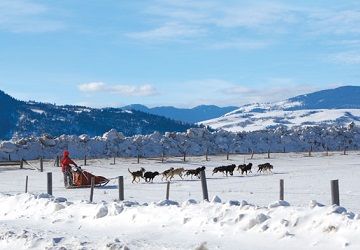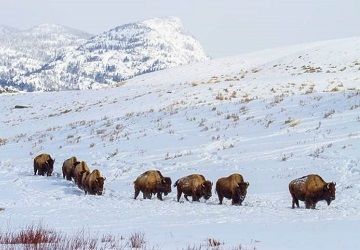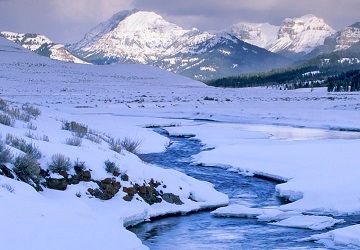Explore Yellowstone National Park in Winter
Winter is a fantastic time to visit Yellowstone National Park. The snow makes for a great backdrop for wildlife and landscape photography. You also won't have to compete with crowds for the vistas.
Image Source: National Park Service

Image Source: National Park Service
Blanketed by snow, Yellowstone National Park exudes a mythical beauty. In winter, the crowds that make Yellowstone the fourth most visited National Park are gone, but the wildlife and the world-famous geysers, as well as the bubbling mudpots, hissing fumaroles (steam vents), and hot springs remain. Minus summer’s visitor throngs, Yellowstone’s canyon, woods, wildlife, and hydrothermal forces seem even more wondrous. In winter, it’s also easier to spot animals because they gather in the lower elevations where the conditions are less harsh.
Winter in Yellowstone National Park
See the geysers against the snow.
The contrast between the snow and the gray-white steam of the geysers creates a heightened sense of the Earth’s powerful forces, especially when you are among the relatively few visitors. In winter when Old Faithful, the geyser that regularly shoots sprays of water more than 100 feet in the air, erupts, the near-boiling water hits the chilly air forming “geyser rain.” Watch as these small, ice-like pellets fall to the ground.
Snowshoe and cross-country ski.
Yellowstone offers miles of trails that lead past icicle-laced woods, steaming hot springs and snow-packed meadows. You won’t soon forget gliding within sight of a bison herd or striding near elk tracks. You can learn about the wildlife and the winter ecology on naturalist guided snowshoe and cross-country tours. These are available through most of February.
Image Source: National Park Service

Image Source: National Park Service
View bison with winter coats.
In winter, balls of snow dangle from the bison’s shaggy coats and the beasts’ breath hangs in the frigid air like fire, making the formidable animals look even more impressive.
See wolves.
Yellowstone, with at least 99 wolves living in 10 packs, rates as one of best places in the world to see these animals. Although wolves roam throughout Yellowstone, Lamar Valley and the Northern Range’s open vistas provide good viewing. The contrast between the wolves’ thick gray or black coats and the snow-covered meadows and hillsides make spotting the wolves easier than in summer.
Image Source: National Park Service

Image Source: National Park Service
Winter Adventures
Park vehicle tours include:
Madison Wildlife Excursion: On this Snowcoach tour, look for birds as well as bison and other mammals along the 7-mile route near the Madison River. Dates: Dec. 17, 2016-Feb. 26, 2017.
Firehole Basin Winter Adventure: Stay warm in your Snowcoach as you follow the Firestone River in search of bison, mule deer, and trumpeter swans. Dates: Dec. 17, 2016-Feb. 26, 2017.
Winter Photo Safari: The driver takes you to some great spots for animal viewing and scenic photographs while the guide offers tips on getting the best winter images. Dates: Dec. 19, 2016-Feb. 24, 2017.
Non-vehicle winter tours include:
Lone Star Excursion: Ski or snowshoe a 5-mile loop on a guided tour that follows the Firehole River through woods and meadows to Lone Star Geyser. You might see trumpeter swans and bison. Dates: Dec. 19, 2016-Feb. 24, 2017.
Old Faithful Snowshoe Tour: From Old Faithful Snow Lodge, snowshoe through forests and along the Firehole River. Look for owls and other birds as well as bison and elk as you explore the backcountry. Dates: Dec. 16, 2016-Feb. 26, 2017.
Winter Wolf Expedition: Spend 4 days looking at and learning about wolves with this program operated by Yellowstone Forever. Dates: Dec. 26, 2016-Feb. 20, 2017.
Wildlife Watching on the Northern Range: Hike, snowshoe, or ski through the northern range as Yellowstone Forever’s naturalists teach you about and search for elk, bison, fox, and moose. Dates: Through March 31, 2017.
Dog Sledding: Mush your own dog sled team across frozen expanses near Yellowstone National Park. Several private outfitters provide trips, including West Yellowstone Dog Sledding and Klondike Dreams.
Follow Candyce H. Stapen on Twitter: @FamilyiTrips
ACTIVA BioACTIVE Bulk Flow Marks Pulpdent’s First Major Product Release in 4 Years
December 12th 2024Next-generation bulk-fill dental restorative raises the standard of care for bulk-fill procedures by providing natural remineralization support, while also overcoming current bulk-fill limitations.